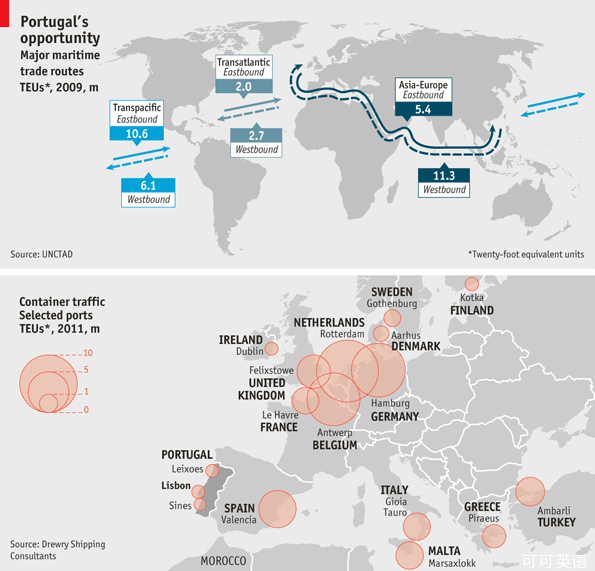(单词翻译:单击)
Finance and Economics;Building euro-zone competitiveness;Ports in the storm;
财经;加强欧元区竞争力之;暴风雨中的港口;
Portugal needs to privatise its ports to reap the full benefits of its location. The latest in our series on reforming Europe's economies
葡萄牙应将港口私有化以完全发挥其区位优势。欧洲经济改革系列之最新进展
Lisbon's harbour mixes pleasure with business. Bars and restaurants sit alongside industrial machinery and colossal container ships. The combination works: shiny cranes gleam in the sunset as tourists and locals eat and drink at the water's edge. But Portuguese ports are a less happy blend of private and public control. The newish government is set to take a fresh look at ports as part of a wider programme of IMF-mandated structural reforms. What should it do?
里斯本(葡萄牙首都)港的商业氛围中不乏欢快。酒吧和餐馆就坐落于工业机械和庞大的集装箱船旁边。这是一种奇妙的搭配:夕阳中,游客和本地人在水畔边吃边喝,起重机则在落日的余晖中闪闪发光。但是葡萄牙由私人经营的和政府掌控的港口搭配在一起,就显得不那么有情调了。新一任政府准备好以新的眼光来看待港口,要将其当做IMF主导的结构性改革更广泛项目的一部分。接下来应该做些什么呢?

Passing through seaports can be expensive, accounting for a big chunk of goods' wholesale costs. Price-sensitive shippers will seek out prime ports, looking for value, speed and reliability. Port efficiency is in turn linked to ownership structure.
船只穿越海港的花费占货物批发成本中的很大一部分,代价高昂。对价格敏感的运货商很看重港口的价值,速度以及可靠性,将会物色主要港口。而港口效率与所有权结构则息息相关。
In general, private-sector involvement improves things. Typical benefits include shorter queuing times, cheaper container unloading, longer opening hours and higher capacity utilisation. Until 1984, Portugal's ports sat at the state-controlled end of the ownership spectrum (much of the country's aviation infrastructure still does). Since then, they have gradually moved to an intermediate public-private “landlord” model. This can work well: the government owns the land and water access, while private firms finance, build and operate tugboats, cranes and warehouses.
一般而言,私人部门参与进来会起到改善作用。典型的好处包括能缩短排队等候时间,降低集装箱卸货价格,延长港口开放时间以及增加设备使用率。直到1984年,葡萄牙的港口的所有权结构还位于所有权谱1的国有控制一端(这个国家的大多航空基础设施现在依然如此)。后来,这种结构逐渐演化为位于中间位置的公-私‘共同所有'模型。这一结构能够较好地起作用:政府拥有土地和水路,私有公司则负责购买,修建并经营拖船,起重机和仓库。
This liberalisation process has made Portuguese ports better—investment has increased capacity and productivity has improved. But further improvements are needed, according to Rui Marquez and Carlos Cruz of the Technical University of Lisbon, if Portugal is to compete effectively for container ship business.
这一自由化进程使得葡萄牙港口发展得更好——投资增加了其吞吐容量,生产力也得到了改善。里斯本技术大学的瑞马吉是和卡洛斯克鲁兹认为,如果葡萄牙想要在集装箱船业有效竞争的话,还需要采取更多的改进措施。
These ships keep on getting bigger. The bulkiest vessels can carry 14,000 twenty-foot containers—a cargo that would require a train 85km (53 miles) long if transported by rail. The result is huge economies of scale: the cost per container on an Asia-to-Europe trip has fallen from around $1,000 to below $300, according to one study.
这些船变得越来越大。最大的船能够装载14000个两英尺长的集装箱——若用铁路运输同样的货物得需要长85千米(53英里)长的火车。这是巨大的规模经济的结果:据一项研究表明,亚洲至欧洲船运的单位集装箱成本已经从1000美元左右降至300美元以下了。
Big ships will stop at only four or five destinations in Europe, raising the stakes for ports trying to win their custom, according to Neil Davidson of Drewry Shipping Consultants. To lure them, ports need deeper harbours and bigger cranes to unload the cargo. They also need to offer an attractive onward route to final customers. This can be overland using trucks, or by sea if the port offers connections with lots of smaller ships. For Portugal, this means competing to serve the cities of Seville and Malaga by lorry or train, or acting as a shipping hub by battling with rival ports in Spain and Morocco.
德鲁里航运咨询公司的尼尔戴维森认为,大船在欧洲只会选择四五个目的地停靠,这增加了港口努力赢取大船惠顾的不确定性。为了吸引他们,港口需要有更深的港湾和更大的起货设备来卸货。同时港口也要为以此港为终点的顾客提供一套令人心动的前行路线。这可能包括利用卡车走陆路,或者是走海路,但前提是港口能够提供与许多更小船只的连接手段。这对葡萄牙而言意味着他要与西班牙和摩洛哥的对手港口竞争,通过卡车或火车竞相为塞维利亚(西班牙地名)和马拉加(西班牙南部省)提供服务,或者是充当一个海运中心。
Portugal should be well-placed to compete. Its coast is right on the enormously busy Asia-Europe shipping route (see map). Its highest-capacity container port—Terminal XXI at the Port of Sines—can handle the biggest ships. It is well within reach of southern Spain, with onward rail and road connections that have been made much better in recent years. But despite improvements between 2009 and 2010, the port is still a minnow by European standards. To make further gains, especially in the ultra price-sensitive transshipment market, Portugal needs to steer past two obstructions: powerful service providers and unionised workers.
葡萄牙的地理位置应该很利于竞争。其海岸刚好位于特别繁忙的亚欧航海路线上(见地图)。位于锡尼什港的容量最大的集装箱港口码头——21号码头——能够停靠世界上最大的集装箱船。锡尼什港与西班牙南部较为接近,近几年铁路和公路的连接也做得更好了。尽管2009年和2010年有所改善,按照欧洲标准,这个港口仍然微不足道。为了赚取更大的收益,特别是在对价格极端敏感的转船装运市场上,葡萄牙需要摆脱过去的两个障碍:强势的服务供应商和加入工会的工人。
Getting private firms to compete at ports is tricky. Setting up an unloading business requires significant investment—a single crane can cost


